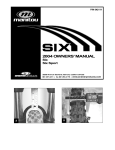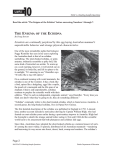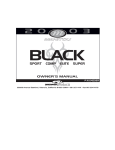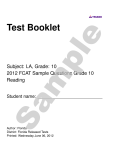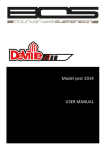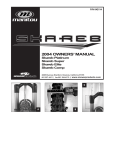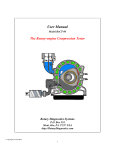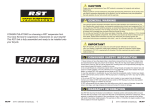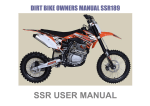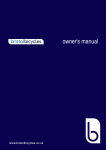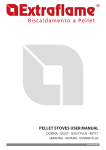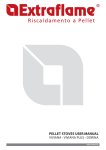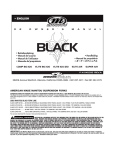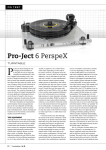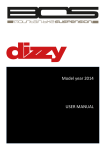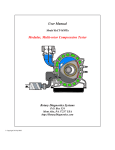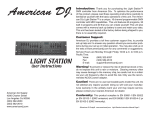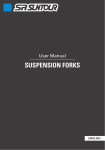Download XENO OWNER`S MANUAL
Transcript
XENO OWNER’S MANUAL www.societyforks.com CONGRATULATIONS on choosing a Society suspension fork. Society forks are produced by one of the World’s largest and most experienced Bicycle Suspension Fork factories; *Dah Ken Industry Co. Ltd. Taiwan (*Owners of the RST brand). This Society fork is fully assembled and ready to be installed. This product should ONLY be installed by an experienced Bicycle Mechanic. CAUTION Proper care and maintenance of your Society product is necessary for longevity and optimum performance. Failing to perform normal maintenance will greatly decrease the performance of the product and may lead to premature deterioration of the product. Lack of maintenance may also jeopardize the safe operation of your fork and will void the warranty. GENERAL WARNING This manual contains important information about the safe operation and maintenance of your fork. Please read this manual entirely, and ensure that you properly maintain your bicycle and suspension fork. To ensure that your Society fork performs properly, we recommend that you have your fork installed by a qualified bicycle mechanic. Prior to riding your bicycle, you should inspect your suspension fork to ensure that no damage has occurred during the course of previous use. Remember, these forks are not a steel girder, and therefore are not indestructible. Do not ride your bicycle if the fork shows any signs of bending, cracking, leaking, or if it is missing any of the originally supplied components. Any fall from your bicycle can result in serious injury or even death. Following these instructions can help you reduce the risk of being injured. We recommend returning your suspension fork to your dealer every year for a thorough inspection and service. IMPORTANT Society Xeno is an off-road fork, and as such, does not come with proper reflectors for on-road use. Have your dealer or mechanic install proper reflectors to meet the legal requirements for bicycles if the fork is going to be used on public roads at any time. CONSUMER SAFETY INFORMATION 1.Never remove or have the steerer tube or stanchions removed from the crown. The steerer tube and stanchion tubes (inner legs) are press fit at the factory. Press fit tubes have a higher performance versus bolt-in tubes, but can not be pressed out. Pressing them out will permanently damage the crown beyond repair and render it unsafe for any use. 2.Do not add threads to a threadless steerer tube. Cutting threads will weaken the steerer tube and cause an unsafe condition. This item is designed for use with 11/8” threadless systems ONLY. Please buy an alternative set-up if you require threaded forks. 3.Any other alteration or modification to your fork should be considered unsafe. Contact your dealer or RST USA warranty service centre prior to modifying your fork in any way for safety information. 4.Do not use your Society forks if any parts are broken, bent, cracked, or you suspect anything may be damaged. Contact your dealer, Society distributor, or RST USA warranty service centre or RST Europe, if you have any question concerning the integrity or condition of your fork. 5.Society recommends that you inspect your fork before every ride for wear and damage. Please pay particular attention to the crown, Stanchion tubes, Sliders, Dropouts and Brace areas for ANY signs of cracks, bending or damage. WARRANTY INFORMATION Any Society fork found by the factory to be defective in materials and/or workmanship within one year from the date of purchase or two years from the date of manufacturing (whichever comes first),will be repaired or replaced at the option of the manufacturer, free of charge, when received at the factory with proof of purchase, freight prepaid. (The warranty in USA is 12months ; the region outside of USA will be subject to the local regulation.) This warranty does not cover any fork that has been subject to misuse or abuse, including but not limited to, any breakage, bending, damage caused by crashes and/or collisions, owner’s neglect, improper installation and/or assembly, improper maintenance, or other excessive, improper or abnormal conditions. This warranty does not cover paint damage. Any modifications or alterations made by the user will render the warranty null and void. This warranty is expressly in lieu of all other warranties, and any implied are limited in duration to the same duration as the expressed warranty herein. Society and Dah Ken Ind. Co. (RST) shall not be liable for any incidental or consequential damages. In the event that a product needs to be replaced and is discontinued or not available, Society and Dah Ken Ind. Co. reserves the right to replace the product with one of equal value. No credits or refunds will be issued. (Your Statutory rights remain unaffected) IMPORTANT USAGE NOTE: This product is not intended for use in stunt or acrobatic riding, ramp jumping, or similar activities, the user assumes that any personal injuries, product damage or failure, and any other losses which may arise under such use. Falling from a Bicycle can cause serious injury or even death, therefore always ride within your capabilities and wear appropriate safety protection clothing. If for any reason warranty work is necessary, return the fork to the place of purchase. In the USA, dealers should call RST USA warranty service center at +1-888 -RST-7731. Customers in countries other than USA should contact their local dealer or distributor or RST Europe. INSTALLATION INSTRUCTION It is extremely important that your Society fork is installed correctly by a qualified bicycle mechanic. Improperly installed forks are extremely dangerous and can result in serious and/or fatal injuries. Ensure that the proper steerer tube has been delivered on your Fork. The steerer tube may need to be cut to length to fit your bicycle head tube. If you are not familiar with this procedure, or do not have the proper tools to cut the steerer tube, it is recommended that you seek a dealer with a qualified bicycle mechanic to perform installation. WARNING The steerer tube and stanchions (inner legs) are a one-time precision press fit at the factory and cannot be removed from the crown. Replacement of the entire crown/steerer assembly must be done to change steerer tube lengths or diameters. Removing and replacing the steerer tube or stanchions will result in an unsafe condition and should never be done. FORK INSTALLATION 1. Remove the old fork from your bike. 2. Measure the length of steerer tube to fit your bicycle head tube, make sure there is sufficient length to clamp the stem (refer to the stem manufacturer’s instructions), you can use your old fork as guide for cutting the steerer tube length. (Tip; Before cutting, add a spacer or 2 under your stem, in case you need to change your stem or headset for taller items at a later date.) 3. Install the headset crown race (as per manufacturer’s instructions) firmly against the top of the fork crown. 4. Clean and lubricate the headset bearings and races. 5. Insert the steerer tube into the head tube of the frame. 6. Install the upper bearings, stem spacers, and stem. 7. Install the stem cap and bolt. Tighten the bolt to headset manufacture’s specifications. 8. Install the handlebars to desired height and torque stem pinch screws or stem clamping system to manufacturer’s specifications. Adjust the headset until you feel no play and drag. 9. Install the brakes and adjust per the manufacturer’s instructions. 10.Install the front wheel – see later section for different axle types. 11.Make sure you check you have adequate tyre clearance; You should allow a minimum of 5mm clearance between the bottom of the fork brace and the top of the tyre. To double check tire clearance, remove the air pressure and/or spring stacks and compress the fork completely to make sure at least a 1/4”(6.4mm) of clearance exists between the top of the tire and the bottom of the crown. 12.Your new fork is designed to break-in during your first few rides (about 20 hours total riding time). Prior to break-in, you may notice your fork feels tight and slightly notchy. Following the break-in period, your fork will feel much smoother and will react to bumps much better than when you first put it on your bike. IMPORTANT Society forks should not be used if any parts appear to be, or are damaged. Contact you local dealer or distributor for replacement parts. SAFETY MAINTENANCE Before every ride, please perform the following inspection: 1.Ensure that wheel fixings are properly adjusted and tight. 2.Wipe the inner legs and clean and check entire fork for any obvious damage. Note: Pay particular attention to ensure that steerer and stanchion tubes are still parallel. (Bending of the fork forwards is a common trait of hard landings.) 3.Check the headset for proper adjustment. 4.Ensure that the front brake cable is properly routed and check brake adjustment. 5.Check top caps, brake posts and shaft bolt for proper torque. 6. Add a small amount of approved grease into the rear grease ports (on sliders). PERFORMANCE MAINTENANCE Every 3 months or more regularly if the performance of the fork has deteriorated; 1.Disassemble fork and thoroughly clean grease and residue from each part. 2.Inspect all parts for damage such as cracks, abrasions, and normal wear. If parts are found to be damaged or excessively worn in any way, replace them immediately. Stop using this product until the damaged or worn parts have been replaced. If all the parts are in usable condition, proceed to step 3. 3.Apply a liberal amount of grease to the upper and lower bushing, stanchion, valve assembly, and wipers. Fill the wipe pocket with a generous amount of grease. Do not use a lithium based grease as it may damage the bushing material. Bushing replacement: Excessive Play; If your forks develop excessive play between the stanchion and Sliders; the bushings are most likely worn-out, and will need to be replaced. IMPORTANT Replacing bushing requires special tools to remove and install the bushing properly. Society strongly recommends this work is done by a qualified mechanic with the proper tools. Improperly installed bushings are extremely dangerous and can result in serious and / or fatal injuries. IMPORTANT 45-60 60-70 75-90 95-105 105-120 5-10 10-25 25-35 35-45 45-60 The above table is for reference only, the rider may change the Kg Rate and preload according to their desires. e.g. You can increase the air pressure to make the fork stiffer for riding on recreational roads to minimize the loss of rider’s energy, or, If a rider wants to ride more comfortably, they may decrease the air pressure to make the fork softer. Note: when the fork pressure is reduced, it is easier to reach the end of available travel harshly. (i.e. Fork can “Bottom Out” – which should be avoided – as it can cause damage to the fork, and the rider) INCREASING AIR PRESSURE; 1. Unscrew the left leg cap and remove. 2. The air fitting is of the schrader valve type. 3. Use the a suspension specific air pump , to pressurize the fork to the desired level. ( Upon removing the air pump, there may be some air lost. Make an allowance for this factor). (Note: To decrease pressure, depress the centre pin of the Schrader valve) ADJUSTING REBOUND DAMPING When rebound damping is increased, the rebound speed may become slow and cause the shock to feel “dead” or “unresponsive”. Therefore, it is best to adjust the amount of rebound damping to suit your own requirements. INSTRUCTION FOR REBOUND DAMPING ADJUSTMENT 1. Turn the adjuster knob clockwise to increase the rebound damping and turn it counterclockwise to decrease the rebound damping. 2. Turn the adjuster knob then test the fork to make sure the rebound damping can meet your requirement. If not, try another 1/ 2 turn. WARNING: Changing the suspension settings on the fork can change the handling and braking characteristics of your cycle. Do not change the adjustment until you are fully familiar with the instructions and recommendations. Always check for changes in handling or braking by taking a careful test ride in a safe environment after each adjustment. LUBRICATION; To ensure the fork’s optimum performance, we recommend regular lubrication with a suspension approved grease. Inject a small amount grease regularly into the 2 rear grease ports using a needle nozzle grease gun. Installing 20mm Front Hub; 1. Slide hub (including 20mm cones) into the legs and line up with axle holes. 2. Apply grease or Anti Seize to the entire 20mm axle. 3. Slide the 20mm Axle into the fork/hub from the Left hand side (Disc side). 4. Gently turn the axle clockwise to connect to the axle threads in the right hand leg. 5. Once located – fully tighten the axle to 6Nm using an 8mm Hex key. 6. Apply grease or anti seize to the Right Hand side Axle lockbolt. 7. Gently screw-in the lockbolt into the 20mm axle end. 8. Hold the Left hand side of the axle with an 8mm Hex key and Fully Tighten the Right Hand side Lock bolt to 6Nm using a 2nd 8mm Hex Key. 9. Check that Disk brake operates correctly. Installing QR type Front Hub; 1. Identify Adaptors and parts. 2. Carefully install grub-screws 3 turns into fork legs – ensuring they are not cross-threaded. (note: this may initially be harder than normal, as the grub screw may have to clear some paint residue in the threads from the leg.) 3. Remove the grub-screws. 4. Lightly Grease the outside of the adaptors. 5. Install the Right hand adaptor into the Right hand leg, taking care to keep the “location Dimples” in line with the grub screw holes in the fork. You should be able to see the Location Dimple by looking down the fork leg hole. 6. Install the grub-screw and tighten gently until it contacts the Adaptor. 7. Back-out the grub-screw 2 full turns, and the gently try to turn the adaptor. You should feel a small amount play, between the grub-screw head and the adaptor “Location Dimple” – and your small turn should be stopped by the grub-screw. If your rotation is not stopped, it means the grub screw head is not entering the “Location Dimple”. Retry. Once you are convinced that the Grub Screw is lined up with the “Location Dimple” – you can fully tighten the grub screw to 3Nm . SAFETY NOTE: It is IMPORTANT that the grub screws are correctly located into the adaptor dimples – IF NOT – the adaptors could rotate and cause a failure. 8. Repeat with Left Hand Adaptor. 9. Remove Nut end and grease Society Skewer Rod (retain conical spring at hex bolt end – largest end towards the hex bolt alloy cover). 10. Install QR type front hub into the installed adaptors. 11. Insert Society Skewer rod into Right hand side dropout adaptor and pass through QR hub. 12. Apply some pressure to compress the conical spring and allow Rod to pass out of the Left Hand side adaptor, and screw-on the Society Skewer nut approx 3 turns onto the rod. 13. Release pressure from spring and allow rod to pull-back, taking care to locate the STEEL tab on the Skewer nut into the Left Hand dropout adaptor notch. 14. Fully tighten the Skewer Rod to 9Nm. Be sure not to overtighten the bolt as this could strip the threads in the alloy nut. 15. Check that brakes are functioning correctly. WARNING 1.Before disassembly of the “Function system”, it is strongly recommended to take it to an authorised dealer. The authorised dealers will provide qualified technicians with proper tools and training to perform service correctly. Improper dis-assembly may damage the product and lead to failure of human injury. 2.Before completing maintenance, please make sure all screws have been securely tightened according to the correct torque settings to avoid any human injury. TOOLS REQUIRED FOR MAINTENANCE 1. 22mm wrench 2. 2,4,6,8mm Allen key 3. Circlip Pliers 4. Air shock pump 5. Torque wrench 6. Small Phillips (No.1) type screwdriver. Torque specification 1. Lower Assembly Bolts 8-9Nm 2. 22mm Hydraulic Top Cap 20Nm To Strip down fork (Experienced mechanics only). 1. Release ALL of the air pressure in the air chamber. 2. Using 4mm Hex key, unscrew the lower “assembly bolts” on both legs 2 turns and tap-in gently to free the internals. Remove the bolts fully. 3. Hold the brace with one hand, and pull the crown/stanchion assembly out from the lower legs. 4. Air Side; (use eye protection) a) carefully remove circlip from base of stanchion and remove the “end cap”. b) Remove compression rod and spring assembly. c) Wipe O-rings and spring stack with clean non linen rag and re-grease. 5. Hydraulic Side; a) Set rebound adjust minimum. b) Undo Phillips screw and carefully remove top cap- taking special care not to loose ball bearing and spring. c) Remove Top cap using 22mm Socket and extract Hydraulic cartridge. note: We do not recommend further disassembly of Hydraulic cartridges. If performance is poor – replace cartridge. 6. Clean the outside of the stanchion tubes and the inside of the sliders with a clean non-linen rag. 7. Apply thin layer of recommended grease to the stanchion tubes and also to the inside of the wiper seal on the sliders. 8. Re-assemble and re-adjust Air pressure and rebound settings. (Note: Use extreme care when re-installing Air Side Circlip… as you will need to compress the Bottom out spring when installing cirlcip - use eye protection.) Apply correct Toque settings as noted above - Do not over tighten. SPARE PARTS Please contact Society or RST distributors for further details about replacement parts. WARNING Do not use the lithium based grease because it may react with some parts (o-ring , wiper, seal) internals and greatly reduce the performance of the fork. General Warning note; As with all mechanical components, the Bicycle is subject to wear and high stresses. Different materials and components may react to wear or stress fatigue in different ways. If the design life of a component has been exceeded, it may suddenly fail possibly causing injury to the rider. Any form of crack, scratches or changing of colour in highly stressed areas indicate that the life of the component has been reached and it should be replaced. Society is a registered Trade Mark of; Ison Distribution Ltd. Cambridge UK. www.societyforks.com RST GLOBAL NETWORK Head quarters Asia Dah Ken Ind. Co., Ltd. Kingdamper Ind. Co., Ltd. Tel : +886-2-85212351 Fax: +886-2-85216159 Email:[email protected] Web:www.rst.com.tw Europe RST Europe B.V. Fax: +31-10-2381050 Email:[email protected] U.S.A USA Warranty Service Center Tel : +1-888-RST-7731 Email:[email protected] China HuiZhou RST Ind. Co., Ltd. Tel : +86-752-3866000 Fax: +86-752-3866020 Email:[email protected] General Warranty and Usage Notes Your Society fork is designed for general off road use and street use. It is not a totally indestructible solid lump of steel capable of being jumped, crashed and thrashed without damage! We appreciate that you may well want to use this fork for riding to extremes, but that is your choice. If you own any product, be it car, truck, motorbike or helicopter and crash it, the manufacturer is not going to replace or repair it unless the product was defective in the first place and caused the accident. If you have bought this fork to race, jump or take part in any competition, the same stuff applies. If you damage a part due to these types of riding, you need to consider the damage an expense of your riding style. Steerer tubes, Stanchion tubes, crowns, braces etc. do not just bend while riding along in a normal manner. Everything has its limits, so please respect them. Jumping (or more correctly - LANDING) is a particularly hazardous aspect of riding, and something we are unable to guarantee forks against. Heavy landings (crashes) apply huge forces to the front area of a bicycle, and a bad landing can easily bend or break any fork (or frame/handlebar). Even an aeroplane, which is designed to both fly and land, will fold on the runway if it is landed badly. However, in that scenario, common sense tells you that it would be a case of pilot error, So really; we would ask you to think more like a pilot; and try to avoid crash landings ! Please also consider that a series of smaller accidents may not individually appear to be significant, but their combined effect can be! Therefore, don’t forget the mistake(s) you made last time out before considering making a warranty claim for a damaged component. At Society forks we like riders; and therefore we will, always do our best to reach an amicable solution with regards to failed parts, whether manufacturing faults or not. HOWEVER; please do not tell porkies about your problems. We like all pilots, both good & bad, but we don’t like folks that twist the truth ! If your fork develops a problem that you feel is a justifiable warranty fault, please return it complete to your dealer for inspection. Where there is a genuine fault, we will arrange for repair or replacement as soon as possible. Outside of the normal warranty, we also operate a crash replacement policy for Society fork owners, therefore, be straight with us and we will do our best to help you. Use advice; The Frame, Forks and Handlebars are the main bicycle components that are prone to catastrophic failure. This is particularly the case with regard to Aluminium components. Aluminium can be very strong, but, if pushed beyond it’s ultimate yield strength, it can simply shear (rather than bend). Also, Aluminium does have a finite fatigue life, meaning that continual stress and shock in amounts that may not individually exceed the ultimate yield strength of the component will add up and could cause the eventual failure of the part. Under conventional on or off-road riding conditions, the components used on Society Forks should not be prone to failure. However; with stunt riding, jumping, competitive racing and other non-conventional bicycle use, the potential shocks and damage caused to components can be enormous. This is why we are unable to offer our warranty for Forks used/abused in those manners. General Safety Advice; HOWEVER, FOR YOUR OWN SAFETY; regularly visually inspect the Frame, Forks and Handlebars for any signs of fatigue, cracks or bending. Pay particular attention to; i) Frame; Downtube and Headtube joint. ii) Fork; Crown and top of Stantion tubes (legs) iii) Handlebar; Central area close to stem clamp. If you hear any unusual cracking or creaking noises from these areas whilst riding; STOP RIDING IMMEDIATELY and investigate the root cause. It may simply be some minor corrosion between the handlebar and stem joint, but it is far safer to check it, because catastrophic failure of one of these components can cause serious injury or even death. If your bicycle has been prone to hard or aggressive riding, (Jumping and landing) it is wise to consider the replacement of critical parts after as little as 2 years, even without signs of imminent component failure. WARNING: REGULARLY INSPECT YOUR BICYCLE FOR SIGNS OF FATIGUE, CRACKS OR BENDING. IF YOU NOTICE ANYTHING UNUSUAL EITHER ; VISUAL OR AUDIBLE; STOP RIDING IMMEDIATELY AND INVESTIGATE THE ROOT CAUSE. Pay particular attention to the following Critical Components; i) Frame; Downtube and Headtube joint. ii) Fork; Crown and top of Stanchion tubes (legs) iii) Handlebar; Central area close to stem clamp. WARNING: Riding with incorrectly adjusted or worn brakes is extremely dangerous and can result in serious injury or death. Is everything else tight and secure? Check that it’s all in working order, then buckle on your helmet and go ride! RIDE SAFELY AND RESPONSIBLY This manual was produced in good faith by Ison Distribution Ltd June 2007. As part of our on going product development, Society Forks and Dah Ken Ind. Co. reserve the right to change applicable specifications and advice contained herein, without notice. Users should seek advice from authorised dealers if they are at all unsure about any aspect of the information contained herein. No responsibility will be accepted for loss or damage resulting from errors or omissions. www.societyforks.com

















